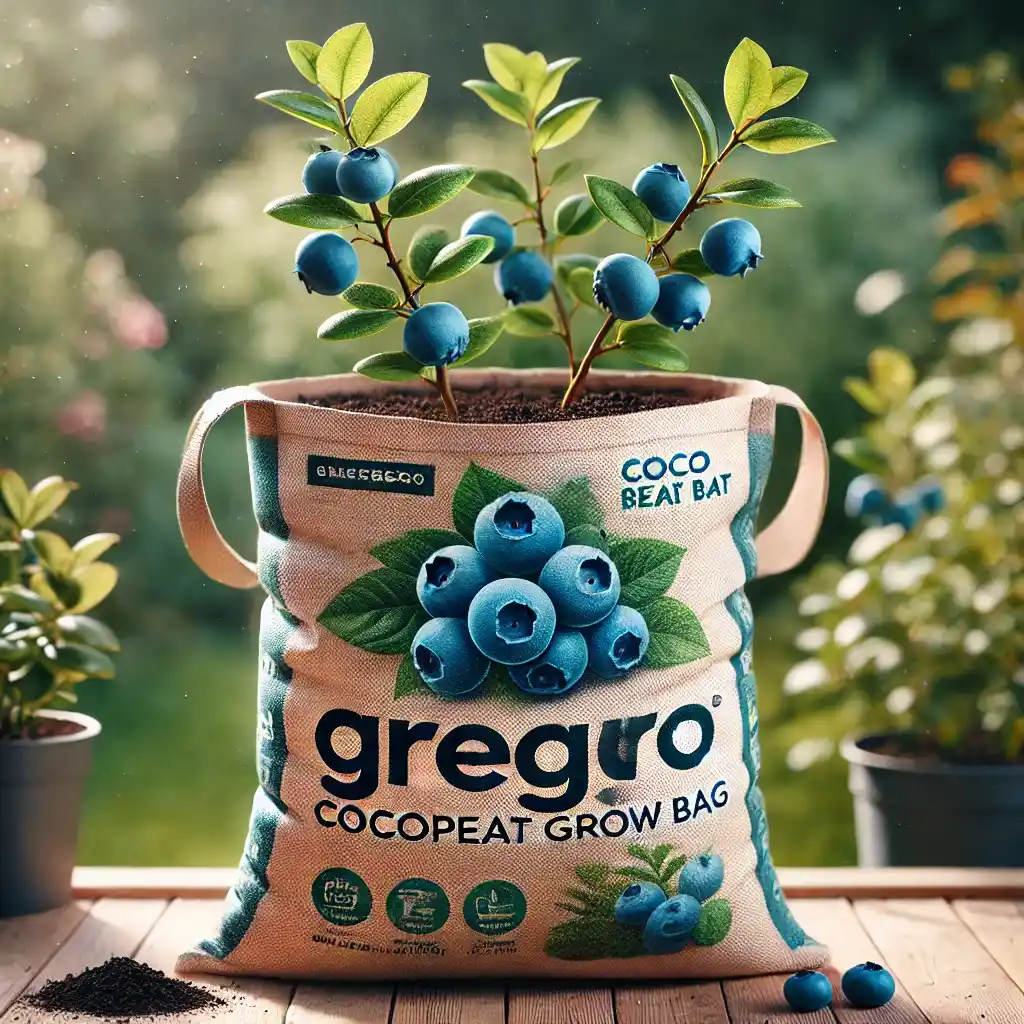How to Grow Blueberries in India Using Cocopith Grow Bags?
Blueberries, with their tangy sweetness and vibrant color, are quickly gaining popularity in India. However, growing blueberries in Indian conditions requires special attention, especially to soil and water requirements. Using cocopeat grow bags or cocopith can make blueberry farming more efficient, sustainable, and productive.In this guide, we will explore blueberry farming using cocopeat to effectively grow blueberries in India, We will also address common questions related to blueberry cultivation, ensuring a successful harvest in India’s diverse climate.
Blueberry cultivation in India is gaining momentum, with successful initiatives in regions like Maharashtra and Himachal Pradesh. Despite the challenges posed by India’s diverse climates, innovative farming practices, such as blueberry farming using cocopeat, have enabled the growth of this nutrient-rich fruit. By utilizing cocopeat as a growing medium, farmers can maintain optimal soil moisture, improve aeration, and create the acidic conditions blueberries require, making cultivation more adaptable to different regions.
What Soil Is Best for Growing Blueberries?
Blueberry growing conditions
Blueberries thrive in acidic, well-draining soils rich in organic matter. A combination of cocopeat, compost, and sand is ideal for creating the perfect growing environment. Stay away from heavy clay soils, as they hold too much water and can lead to root rot.
climate Requirements
Blueberries thrive in areas with cool winters and adequate chilling hours. Regions with temperate climates, such as parts of Himachal Pradesh and Maharashtra, are suitable. In warmer areas, protective structures like low-cost tunnels can help regulate temperature and extend the growing season.
Additionally, blueberry farming using cocopeat can improve soil moisture retention and aeration, making it easier to cultivate blueberries even in challenging climates.
How to Make Blueberries Sweeter?
The sweetness of blueberries depends on factors like sunlight, watering, and nutrient availability. Here’s how to enhance their flavor:
Provide Plenty of Sunlight
Blueberry plants need at least 6–8 hours of direct sunlight each day. More sunlight helps the berries produce more natural sugars, making them taste sweeter.
2. Water Properly
Keep the soil moist but not soggy. Water deeply but less often to encourage strong root growth. Avoid overwatering, as too much water can dilute the fruit’s sweetness.
3. Feed the Plants Right
Use an acidic fertilizer designed for blueberries. A balanced mix of nitrogen, phosphorus, and potassium helps berries develop a rich, sweet flavor.
4. Prune Regularly
Trim old and weak branches to improve air circulation and sunlight penetration. Healthier branches produce better-quality fruit.
5. Mulch for Moisture Retention
Apply a layer of pine needles or wood chips around the base of the plant. This keeps the soil acidic, retains moisture, and prevents weeds from competing for nutrients.
6. Pick at the Right Time
Ripe blueberries have a deep blue color with a slight dusty appearance. Let them stay on the bush for a few extra days after turning blue to increase their sugar content.
Follow these simple steps, and you’ll enjoy sweeter, juicier blueberries every season!
What Is the Water Trick for Blueberries?
The water trick for growing sweet and juicy blueberries in India focuses on maintaining the right moisture level without overwatering. Since India has diverse climates, proper watering techniques can help blueberries thrive. Here’s how:
Use Acidic Water (pH 4.5–5.5)
Blueberries need acidic soil to absorb nutrients properly. If your water is too alkaline, mix a few drops of lemon juice or vinegar per liter of water to lower the pH.
2. Deep Watering, Not Frequent Sprinkling
Instead of light daily watering, water deeply once every 2–3 days. This encourages deep root growth, making plants more drought-resistant.
3. Early Morning Watering
Water the plants in the early morning to prevent evaporation and allow the roots to absorb moisture before the day heats up.
4. Drip Irrigation for Consistent Moisture
A drip irrigation system provides slow, steady moisture, keeping the soil evenly moist without overwatering. This is ideal for India’s hot climate.
5. Mulch to Retain Moisture
Spread pine needles, coconut husk, or wood chips around the base to keep the soil moist for longer. This also helps maintain the acidic soil condition blueberries love.
6. Rainwater Collection
If possible, collect and use rainwater, as it’s naturally acidic and free from chemicals that can affect blueberry growth.
By following these simple watering tricks, you can grow healthy, sweet blueberries even in India’s climate!
Fertilization
- Acidic Fertilizers: Use fertilizers designed for acid-loving plants. Avoid fertilizers with high levels of nitrogen, as blueberries are sensitive to over-fertilization.
- Organic Matter: Incorporate compost or peat moss to enrich the soil with nutrients.
Tips to Prevent Excess Fertilization in Blueberries
1. Check Soil pH and Nutrient Levels
Before applying any fertilizer, test your soil to determine its pH and nutrient content. Blueberries grow best in acidic soil with a pH between 4.5 and 5.5. A soil test helps identify deficiencies so you can add only the necessary nutrients.
2. Use the Right Type of Fertilizer
Blueberries need a balanced fertilizer with equal amounts of nitrogen, phosphorus, and potassium (NPK). Opt for slow-release fertilizers instead of quick-release options to ensure steady nutrient absorption. Organic choices like compost, well-rotted manure, or pine needle mulch are excellent for long-term soil health.
3. Apply Fertilizer Gradually
Instead of applying a large amount at once, divide the fertilizer into small doses throughout the growing season. This prevents nutrient overload, which can burn the roots, reduce fruit quality, and stunt growth.
4. Fertilize at the Right Time
The best time to fertilize blueberries is early spring, just before new growth starts. Avoid fertilizing late in the season, as this can lead to excessive new growth, making plants vulnerable to frost damage.
5. Follow Recommended Fertilizer Dosages
Using more fertilizer than recommended does not speed up plant growth—instead, it can harm the roots and lower fruit production. Always stick to the manufacturer’s instructions and measure accurately to avoid excess application.
6. Use Mulch to Boost Nutrients Naturally
Applying mulch around blueberry plants with pine needles, sawdust, or peat moss helps maintain soil acidity and provides essential nutrients. Mulching also retains moisture, prevents weeds, and improves soil health.
7. Keep an Eye on Your Plants
Regularly observe your blueberry plants for any signs of overfertilization, such as yellowing, curling, or wilting leaves. If you notice any negative changes, stop fertilizing immediately and flush the soil with water to remove excess salts.
Providing the right nutrients to blueberries is essential, but too much fertilizer can cause more harm than good. By testing soil, using slow-release fertilizers, applying them in small doses, and monitoring plant health, you can ensure strong, productive blueberry bushes without the risks of overfertilization.
Spacing and Air Circulation
- Proper Spacing: Space blueberry bushes 4–5 feet apart to allow for proper air circulation and prevent fungal diseases.
- Pruning: Regularly prune old or weak branches to encourage healthy growth and better fruit production.
Protection from Pests
- Netting: Protect the plants with netting to keep birds and other pests from eating the berries.
- Pest Control: Monitor for common pests like aphids or caterpillars and address any infestations promptly.
Container Growing
Suitable for Containers: Blueberries can also be grown in containers. Use a large pot with acidic potting mix and ensure good drainage.
By providing these conditions, you can grow healthy, productive blueberry plants with sweet, flavorful berries!
Innovative Cultivation Practices
To adapt blueberries to India’s varied climates, farmers have employed methods such as:
-
Protective Tunnels: Utilizing low-cost tunnels shields plants from extreme temperatures, reduces water usage, and enhances fruit yield.
-
Soil Management: Amending soil with organic materials and ensuring proper drainage are crucial for plant health and productivity.

Bueberry farming using cocopeat
Before diving into the process, let’s understand why cocopith is a game-changer for blueberry farming. Cocopith, also known as cocopeat, is a natural fiber extracted from coconut husks. It is an eco-friendly growing medium that retains moisture, provides excellent aeration, and maintains a balanced pH level, which is essential for blueberries.
In fact, many cocopeat or cocopith suppliers in India recommend cocopeat grow bags specifically for crops like blueberries because they thrive in slightly acidic, well-aerated soils. Furthermore, using cocopeat minimizes water wastage and supports sustainable farming practices.



Why Use Cocopith for Blueberry Farming?
Advantages of Cocopeat for Blueberries
- Optimal pH Levels:Maintain the soil’s pH between 4.5 and 5.5, as blueberries thrive in slightly acidic conditions.
- Excellent Water Retention: Cocopeat retains moisture while preventing waterlogging, ensuring the roots stay hydrated but not oversaturated.
- Enhanced Root Aeration: Its porous structure promotes good airflow to the roots, preventing root rot and encouraging healthy growth.
- Eco-Friendly: Cocopeat is renewable, biodegradable, and reduces the need for chemical fertilizers.
Can We Use Cocopeat Directly for Blueberries?
Cocopeat can be used directly, but it is recommended to buffer it before planting blueberries. Raw cocopeat may have high salt content, which can harm blueberry roots. To prepare cocopeat
1. Select the Right Variety of Blueberries
First and foremost, choose a blueberry variety that suits Indian climatic conditions. Southern Highbush and Rabbiteye varieties are known to adapt well to India’s warm climate. Research local nurseries or consult with a cocopith supplier who might have insights into suitable varieties for your region.
2.Prepare Your Cocopeat Grow Bags
Next, prepare your cocopeat grow bags or source pre-filled grow bags from a reliable cocopith manufacturer. If you’re preparing them yourself:
What Is the Best Potting Mix for Blueberries?
The ideal potting mix for blueberries should be:
Example Potting Mix Recipe for Blueberries:
- 40% Cocopeat
- 30% Sand
- 20% Compost
- 10% Pine Bark or Sawdust
- Soak the cocopeat block in water to expand it.
- Fill the grow bags with the moistened cocopeat.
- Ensure the cocopeat is well-drained but retains enough moisture for the plants.
- Optimize the pH Level
Blueberries thrive in slightly acidic conditions, with an ideal pH range of 4.5 to 5.5. While cocopeat is naturally pH-neutral to slightly acidic, it’s important to test and adjust the pH if needed. A cocopith manufacturer often provides pre-buffered cocopeat, saving you time and effort.
- Plant Your Blueberry Bushes
Now, plant the blueberry saplings in the cocopeat grow bags. Follow these steps:
- Dig a small hole in the center of the grow bag.
- Place the sapling carefully, ensuring the roots are spread evenly.
- Cover the roots with cocopeat and water the plant lightly.
- Watering and Fertilization
Cocopith retains water effectively, reducing the need for frequent watering. However, blueberries are sensitive to overwatering, so monitor the moisture levels regularly. A drip irrigation system works best to ensure even watering.
For fertilization:
- Use organic or slow-release fertilizers high in nitrogen, phosphorus, and potassium.
- Don’t overuse fertilizers, as too much can damage roots and cause burns.
- Provide Proper Sunlight
Blueberries require plenty of sunlight to produce high-quality fruits. Place the grow bags in an area that receives at least 6–8 hours of sunlight daily. If you’re farming in greenhouses, use shade nets to control light intensity.
- Prune Regularly
Prune blueberry bushes regularly to keep them healthy. Cut away dead or diseased branches and thin crowded areas to let in more light and improve airflow.
- Monitor for Pests and Diseases
Blueberries are susceptible to certain pests and diseases, such as aphids, spider mites, and fungal infections. Inspect your plants regularly and take preventative measures like using organic pesticides. A well-maintained cocopeat grow bag system reduces the risk of root rot and fungal infections due to its superior drainage properties.
Benefits of Using Cocopeat for Blueberry Farming in India
- Sustainability: Cocopeat is a renewable resource, making it an eco-friendly alternative to traditional soil. By sourcing from a reliable cocopith supplier, you support sustainable agriculture.
- Water Efficiency: In India, water scarcity can be a major challenge for farmers. Cocopeat retains water effectively, ensuring your blueberry plants stay hydrated while conserving water.
- Improved Yield: Blueberries grown in cocopeat experience healthier root development, better nutrient absorption, and higher yields compared to traditional soil.
- Ease of Use: Cocopeat grow bags are lightweight, easy to handle, and require minimal maintenance. Many cocopith manufacturers offer ready-to-use grow bags that simplify the farming process.
Finding the Right Cocopith Supplier or Manufacturer
To ensure success in blueberry farming, it’s crucial to work with a reliable cocopith supplier in Tamil Nadu or other regions in India. Look for suppliers who provide:
- High-quality, pre-buffered cocopeat.
- Customized grow bags tailored for blueberries.
- Guidance on optimal usage and maintenance.
Blueberry season in india
In India, the blueberry harvesting season typically occurs during the months of March, April, and May. This timing aligns with the ripening period of the fruit, which is approximately 45 to 65 days after flowering. Flowering usually takes place in early spring, leading to fruit ripening in the aforementioned months.
It’s important to note that blueberry cultivation in India is still in its nascent stages, with production primarily concentrated in regions such as Uttarakhand (Rourkee and Dehradun), Maharashtra, Madhya Pradesh, and the Nilgiri Hills. As cultivation practices evolve and expand, the harvesting period may vary slightly depending on local climatic conditions and the specific blueberry varieties grown.
For those interested in cultivating blueberries at home, it’s essential to provide the plants with the appropriate conditions, including acidic soil with a pH between 4.5 and 5.5, adequate sunlight, and proper watering practices. Typically, it takes about 6 months for the plant to become bushy, with fruiting occurring in 1 to 2 years after planting.
By adhering to these guidelines and understanding the local growing conditions, gardeners in India can successfully cultivate and enjoy fresh blueberries during the peak season.
Blueberry farming in India using cocopeat grow bags or cocopith is not only sustainable but also highly productive. By following the steps outlined above, you can create an ideal environment for blueberries to thrive. Whether you’re a small-scale gardener or a commercial farmer, partnering with a reputable cocopith manufacturer ensures you have the best tools for success.
As demand for blueberries grows, leveraging eco-friendly solutions like cocopeat can position you as a forward-thinking farmer contributing to sustainable agriculture. Start your journey today and see the difference cocopeat can make!

